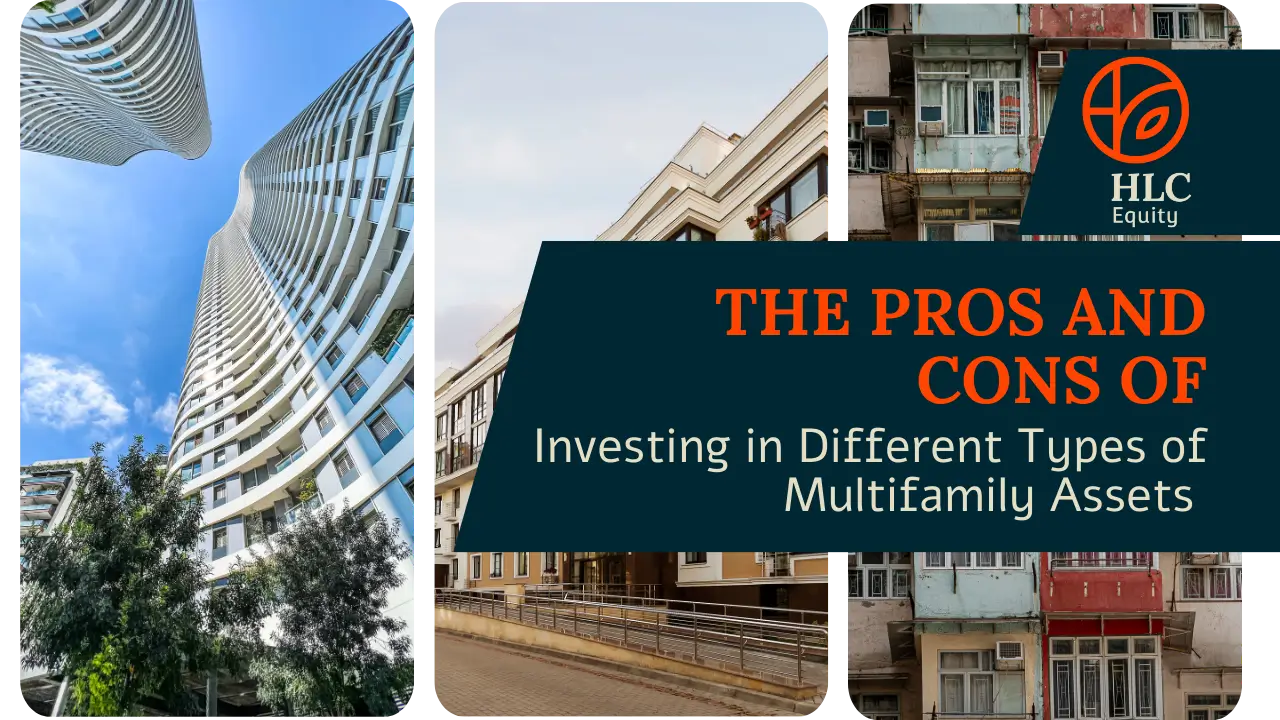
HLC EQUITY
The Pros and Cons of Investing in Different Types of Multifamily Assets
Multifamily real estate is a popular and profitable asset class for many investors. However, not all multifamily properties are created equal.
Depending on the age, location, condition, and amenities of a property, it can be classified as Class A, B, or C (or lower). Each class has its distinct advantages and disadvantages and requires a different investment strategy and risk-reward profile.
In this article, we will explain the main characteristics and differences of each class and share some insights from our experience as a seasoned multifamily investor, owner, and operator.
It should be noted that these are generalities, and not all properties will have the characteristics we outline.
These are purely from our experiences and always recommend investors perform their own due diligence on any investment opportunity.
Class A Properties
Class A properties are the newest, most luxurious, and most expensive multifamily assets in the market.
They are typically located in prime areas with high demand, such as downtowns, urban cores, or affluent suburbs. They offer the best amenities and features, such as pools, gyms, business centers, pet facilities, and high-end finishes.
They attract the highest-income residents who are willing to pay premium rents for convenience and comfort.
The main benefits of investing in Class A properties are:
- Stable And Predictable Cash Flow. Class A properties have high occupancy rates and low turnover, as residents tend to stay longer and renew their leases. They also have lower maintenance and repair costs, as the properties are newer and in better condition.
- Appreciation Potential. Class A properties tend to appreciate faster than other classes, as they are more desirable and competitive in the market. They also have higher resale value, as they appeal to a wider pool of buyers, including institutional investors and REITs.
- Tax Advantages. Class A properties can benefit from depreciation deductions, which can lower the taxable income and increase the cash-on-cash return. They can also qualify for tax credits or incentives for green or energy-efficient features.
The main drawbacks of investing in Class A properties:
- High Entry Barrier. Class A properties have the highest acquisition costs, as they command the highest price per unit and cap rates. They also require more equity and debt financing, which can reduce the leverage and return on investment.
- Market Risk. Class A properties are more sensitive to market fluctuations, as they depend on the economic conditions and income levels of the residents. They are also more vulnerable to oversupply and competition, as new developments can erode their market share and rental rates.
- Lower Yield. Class A properties have lower cash-on-cash returns, as they have higher operating expenses and debt service. They also have lower cap rates, which reflect the lower risk and higher quality of the assets.
Class B Properties
Class B properties are older, more affordable, and more functional multifamily assets in the market.
They are typically located in secondary or tertiary areas with moderate demand, such as suburban or rural neighborhoods.
They offer basic amenities and features, such as laundry facilities, parking lots, and standard finishes. They attract middle-income residents who are looking for value and quality.
The main benefits of investing in Class B properties are:
- Value-Add Potential. Class B properties have more room for improvement, as they can be renovated or upgraded to increase their appeal and performance. They can also be repositioned or rebranded to target a different tenant segment or market niche.
- Higher Yield. Class B properties have higher cash-on-cash returns, as they have lower operating expenses and debt service. They also have higher cap rates, which reflect the higher risk and lower quality of the assets.
- Diversification. Class B properties can diversify the portfolio, as they have different risk-return profiles and market cycles than Class A properties. They can also hedge against inflation, as they can raise rents faster than Class A properties.
The main drawbacks of investing in Class B properties are:
- Capital Expenditure. Class B properties require more capital expenditure, as they need more maintenance and repair, as well as renovation and upgrade. They also have shorter economic lives, as they depreciate faster than Class A properties.
- Tenant Risk. Class B properties have higher tenant risk, as they have lower occupancy rates and higher turnover, as residents tend to move more frequently and default more often. They also have lower tenant quality, as they have lower credit scores and income levels.
- Regulatory Risk. Class B properties have higher regulatory risk, as they are more subject to environmental, health, and safety regulations, as well as rent control and eviction laws. They also have lower compliance standards, as they may not meet the latest codes and requirements.
Class C Properties
Class C properties are the oldest, most basic, and least expensive multifamily assets in the market.
They are typically located in distressed or declining areas with low demand, such as inner cities or remote towns.
They offer minimal amenities and features, such as common areas, storage spaces, and outdated finishes.
They attract low-income residents who are looking for cheap and accessible housing.
The main benefits of investing in Class C properties are:
- High Cash Flow. Class C properties have high cash flow, as they have low acquisition costs and operating expenses. They also have low debt service, as they are usually purchased with cash or seller financing.
- High Demand. Class C properties have high demand, as they cater to a large and stable tenant base, such as students, seniors, immigrants, or low-wage workers. They also have low vacancy rates, as there is limited supply and competition in the market.
- Distress Opportunities. Class C properties can offer distress opportunities, as they can be acquired at a discount from motivated sellers, such as banks, lenders, or owners. They can also benefit from market recovery, as they can appreciate faster than other classes.
The main drawbacks of investing in Class C properties are:
- High Risk. Class C properties have high risk, as they are exposed to various challenges and uncertainties, such as crime, vandalism, fire, flood, or natural disasters. They also have low tenant quality, as they have high delinquency and eviction rates, as well as social and behavioral issues.
- Low Appreciation. Class C properties have low appreciation, as they have limited growth potential and exit options. They also have low resale value, as they appeal to a narrow pool of buyers, mainly cash investors or flippers.
- Management Intensive. Class C properties are management intensive, as they require more time and effort to operate and maintain. They also require more expertise and experience to deal with the complex and dynamic issues of the properties and residents.
At HLC Equity, we lean heavily into our 70 years of experience in the multifamily investment business to help drive our strategy moving forward. Our investment strategy is largely focused on Class B properties, as we believe they offer the best risk-adjusted returns and value-add opportunities in the current market.
We target properties that may be underperforming, undervalued, or undermanaged, and apply our proven operational and capital improvement programs to enhance their performance and value.
We also leverage our strong relationships and reputation in the industry to source and secure attractive deals, as well as to access favorable financing and exit options. CEO, Daniel Farber, explains our philosophy and approach:
“We are passionate about creating and maintaining long-term partnerships with our investors, residents, and communities. And this reflects into the properties we acquire. While we are committed to delivering consistent and higher risk adjusted returns, we are also dedicated to improving and enriching the neighborhoods and markets where we operate.”
Director of Acquisitions, Caesar Nguyen, shares his insights and outlook on the multifamily market:
“Although the market has been unpredictable, at this point in the cycle, we see more opportunity in the long-term prospects of the multifamily sector, particularly in the B class segment. We believe that these offer more resilience and stability than Class A now, as they are less affected by market cycles and competition. We also believe that these segments have more upside and growth potential, as they can benefit from renovation, repositioning, and rebranding strategies.”
Multifamily real estate is a diverse and dynamic asset class that offers various benefits and challenges for investors.
Depending on the class of the property, investors can expect different levels of risk, return, and opportunity.
We recommend investors carefully evaluate and understand the characteristics and differences of each class and choose the one that best suits their goals and preferences. —-
At HLC Equity, we have the expertise and experience to help investors navigate and succeed in the multifamily market. We invite you to explore our current and past projects, and to contact us if you are interested in joining our network of partners and investors.
Disclaimer: This article is for informational purposes only and does not constitute financial advice. Readers are encouraged to conduct their own research and consult with financial professionals before making investment decisions.


